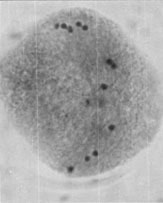Cucurbit Genetics Cooperative Report 10:37-38 (article 22) 1987
L. Zagorcheva, M. Alexandrova and C. Kichukova
Maritsa Vegetable Crops Research Institute, Plovdiv, Bulgaria
Haploid forms in the genus Cucumis ficifolius have not been reported previously in the literature. Tetraploid (2n=48) (1,2) and hexaploid (2n=72) forms (1) have been established. With C. ficifolius (2n=24) autonomous apomictic propagation has been found (3), both after the isolation of non- fertilized female flowers and when hybridized with C. sativus, C. melo var. flexuosus, etc. Progenies resulting from crosses of C. ficifolius with C. sativus and C. melo var. flexuosus appeared to be matromorphic. In the progeny of isolated non-fertilized female flowers of C. ficifolius, one out of eight plants had a chromosome number of 2n=12. it is evident that besides the unreduced egg cells, egg cells with reduced chromosome number in C. ficifolius embryo sacs are capable of apomictic development as well.
These haploids develop slowly, but preserve the species traits. Plants are as tall as the original diploids, but its leaves are smaller and deeper cut. Staminate and pistillate flowers are smaller, with shorter petioles, and have petals that are not joined at the base.
Meiosis in pollen mother cells of the haploids is characterized by disturbances. During diakinesis, 12 non-spiralized chromosomes are established. During Metaphase I they are strongly spiralized and in 92.9% of pollen mother cells, they are scattered along the divisional spindle that is most often considerably elongated and twisted (Fig. 1). It is followed by mitosis and diad formation of microspores (Fig. 2). It is evident that the haploid has inherited from the parent plant the ability to form unreduced gametes. In 7% of pollen mother cells chromosomes are incorporated into the metaphase plate, and from Metaphase I through Anaphase I, 1 to 10 chromosomes are divided into chromatids. Through Anaphase I different numbers of chromosomes move in the direction of the divisional spindle poles, but most often it is 6+6. In Metaphase II and Anaphase II, the location and division of chromosomes is irregular. In a part of the pollen mother cells, three-pole divisional spindles are formed. Microspore types consisted of diads (66.7%), tetrads (18.6%), polyads (11.0%) and triads (3.7%). Only 28% of the pollen is fertile.
When self -pollinated, the haploid did not set fruits. When crossed with C. sativus, 80% of the pollinated flowers set fruits with seeds. The average seed number per fruit was 3.5. The embryo takes up half of the volume of the seed. On an artificial medium in culture, the white part of the seed formed plants that died of secondary infections. The haploid can be maintained through in vitro propagation from apical meristems.
This is the first case we know of where the incompatibility barrier between the wild species of Cucumis in the melo group and Cucumis sativus L. has been overcome.
Figure 1. Pollen mother cells with 12 chromosomes MI-AI).

Figure 2. Dyad from microspores.

Literature Cited
- Dane, F. and T. Tsuchiya, 1976. Chromosome studies in the genus Cucumis. Euphytica 25:367-374.
- Shimotsuma, M., 1965. Chromosome studies of some Cucumis species. Seiken Ziho 17:11-16.
- Zagorcheva, L., 1985. Autonomous apomictic propagation of Cucumis ficifolius A. Rich and C. anguria. Genetics and Breeding: 18 no. 5.